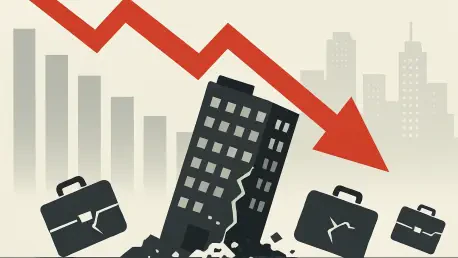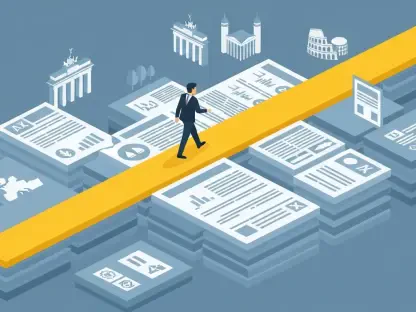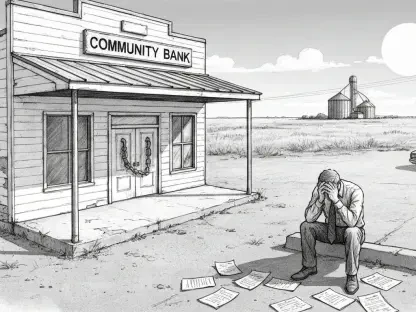The landscape of corporate America is facing an unprecedented challenge as bankruptcy filings have surged to a 15-year high, with 655 cases recorded through October of this year, according to recent data. This staggering statistic paints a grim picture of financial distress across multiple sectors, raising alarms among investors, policymakers, and business leaders. Amid economic volatility, inflation pressures, and looming policy uncertainties, the question remains: what is driving this wave of corporate collapse, and how can stakeholders navigate these turbulent waters? This roundup gathers diverse opinions, analyses, and actionable tips from industry experts, financial analysts, and economic observers to shed light on the causes, impacts, and potential solutions to this pressing issue.
Exploring the Causes Behind the Bankruptcy Surge
Economic Pressures and Tightening Financial Conditions
Industry analysts widely agree that macroeconomic challenges are at the core of the rising bankruptcy numbers. Inflation at decades-high levels has squeezed corporate margins, while the Federal Reserve’s interest rate hikes over the past few years have tightened financial conditions, making debt servicing a daunting task for many firms. Reports indicate a peak of 76 filings in August, the highest monthly total in recent memory, with 68 more in October alone, signaling persistent strain.
Some financial experts argue that these pressures are not merely cyclical but indicative of deeper vulnerabilities in corporate structures. Businesses that over-leveraged during periods of low interest rates are now grappling with repayment challenges as borrowing costs soar. This perspective emphasizes the need for companies to reassess their debt strategies in light of sustained economic headwinds.
A contrasting view suggests that while the current environment is harsh, it may represent a necessary correction after years of unchecked growth. Certain market watchers note that the purge of weaker firms could pave the way for stronger, more resilient enterprises to emerge, provided that systemic risks are contained. This debate underscores the complexity of interpreting the current crisis.
Sector-Specific Challenges in the Spotlight
The industrials sector, with 98 insolvency claims this year, stands out as particularly vulnerable, largely due to supply-chain risks exacerbated by potential tariff policies. Economic commentators highlight how these uncertainties disrupt operations, especially for companies reliant on global trade networks. Consumer discretionary firms, with 80 filings, are also hard-hit as inflation erodes purchasing power among lower-income households.
Analysts focusing on labor market trends point out that weakening employment conditions and rising input costs are compounding the struggles for these sectors. Companies unable to pass on increased costs to consumers face shrinking profits, often leading to insolvency. This dynamic illustrates the interconnected nature of economic challenges across industries.
A differing opinion among sector specialists suggests that while certain industries are suffering, others may find opportunities in restructuring. Some believe that targeted policy interventions could help stabilize at-risk sectors, preventing cascading failures. This viewpoint calls for a balanced approach to address immediate distress while fostering long-term resilience.
Policy Uncertainties and Their Impact on Corporate Stability
Tariffs and Trade Disruptions as Key Stressors
Policy uncertainties, particularly around potential tariffs, have emerged as a significant concern for many businesses, especially in the industrials sector. Trade analysts warn that such measures could further strain supply chains already battered by global disruptions. The fear of increased costs and reduced market access is pushing some firms toward financial distress.
A segment of economic advisors argues that the impact of tariffs might be overstated, as companies could adapt by diversifying supply sources or renegotiating contracts. However, they acknowledge that the transition period could be painful, with smaller firms less equipped to absorb the shocks. This perspective highlights the uneven burden of policy shifts across corporate scales.
Others caution against underestimating the broader implications of trade policy changes on global markets. Some industry observers note that regional trade dynamics could shift dramatically, creating new risks for US firms dependent on international partnerships. This uncertainty fuels a broader discussion on how political decisions shape economic outcomes.
Credit Market Risks and Financial Fallout
The ripple effects of corporate bankruptcies are keenly felt in the multi-trillion-dollar global credit market, with significant charge-offs reported by major financial institutions. Analysts point to examples like a $170 million loss tied to a subprime lender’s collapse as evidence of mounting credit stress. Such events have rattled debt investors and raised questions about systemic stability.
Some banking sector experts draw parallels to past credit crises, warning that high-profile bankruptcies with liabilities exceeding $10 billion could expose broader vulnerabilities. They suggest that financial institutions may tighten lending standards as a precaution, potentially limiting access to capital for struggling firms. This defensive posture could slow recovery efforts.
On the other hand, a few market strategists believe the credit market’s response might be a catalyst for reform. They advocate for stress-testing financial models and enhancing transparency to mitigate future risks. This optimistic take sees the current turmoil as an opportunity to strengthen the financial ecosystem against similar shocks down the line.
Strategies and Tips for Navigating the Crisis
Business Recommendations for Survival
Corporate advisors emphasize the importance of proactive debt restructuring to weather the current storm. Firms are encouraged to renegotiate terms with creditors and prioritize cash flow management to avoid insolvency. This approach aims to provide breathing room for companies under immediate pressure.
Diversifying supply chains is another critical strategy highlighted by supply chain experts. By reducing reliance on single sources or regions prone to policy disruptions, businesses can build greater resilience against external shocks. This tip is particularly relevant for industries vulnerable to tariff-related uncertainties.
Financial consultants also stress the value of stress-testing business models against various economic scenarios. Simulating inflation spikes or interest rate increases can help identify weak points before they become fatal. This forward-thinking mindset is seen as essential for long-term sustainability in an unpredictable market.
Guidance for Investors and Policymakers
For investors, vigilance in monitoring credit market health is paramount, according to financial planners. Keeping a close eye on bankruptcy trends and credit ratings can inform smarter investment decisions, minimizing exposure to high-risk sectors. This cautious approach is advised to protect portfolios amid volatility.
Policymakers, meanwhile, are urged by economic think tanks to consider targeted relief for vulnerable industries. Temporary measures like tax incentives or grants could stabilize at-risk firms, preventing broader economic fallout. Such interventions are viewed as a way to bridge the gap until market conditions improve.
Some policy analysts also advocate for clearer communication around trade and fiscal policies to reduce uncertainty. Providing businesses with predictable frameworks can facilitate better planning and investment, potentially curbing the bankruptcy surge. This recommendation underscores the role of government in shaping corporate confidence.
Reflecting on the Roundup of Insights
Looking back, this compilation of perspectives revealed a multifaceted crisis driven by inflation, interest rate hikes, and policy uncertainties that fueled a 15-year high in US corporate bankruptcies. The diversity of opinions—from economic analysts warning of systemic risks to sector specialists identifying restructuring opportunities—painted a comprehensive picture of the challenges and potential pathways forward. For stakeholders, the actionable steps included debt restructuring for businesses, credit market monitoring for investors, and targeted relief from policymakers. Moving ahead, a deeper exploration of sector-specific recovery plans and ongoing policy developments is recommended to stay informed and prepared for evolving economic conditions.









